National report: Apparent opioid-related deaths in Canada
(released September 2018)
Suggested citation
Special Advisory Committee on the Epidemic of Opioid Overdoses. National report: Apparent opioid-related deaths in Canada (January 2016 to March 2018) Web-based Report. Ottawa: Public Health Agency of Canada; September 2018.
Key findings
The opioid crisis has affected every part of the country, but there are clear differences in death rates and the substances involved across provinces and territories. According to available data reported as of September 12, 2018:
- there were more than 8,000 apparent opioid-related deaths between January 2016 and March 2018 (3,005 in 2016 and 3,996 in 2017)
- from January to March 2018, there were at least 1,036 apparent opioid-related deaths; 94% were accidental (unintentional)
- national trends in 2018 (from January to March) continue to reflect those observed in 2017
- most accidental apparent opioid-related deaths involved fentanyl or fentanyl analogues (73%)
- most accidental apparent opioid-related deaths occurred among males (77%)
- individuals between the ages of 30 and 39 represent the highest proportion (27%) of accidental apparent opioid-related deaths
- the number of accidental apparent opioid-related deaths involving fentanyl or fentanyl analogues increased by 16% compared to the same time frame in 2017, and doubled compared to the same time frame in 2016
It is expected that these numbers will change as additional data become available.
On this page:
- Background
- 1.0 Apparent opioid-related deaths in Canada
- 2.0 Accidental apparent opioid-related deaths
- 3.0 Apparent opioid-related deaths: suicide
- Considerations and Limitations
Background
Canada continues to experience a serious opioid crisis. Across the country, it is having devastating effects on families and communities. The Government of Canada works closely with the provinces and territories to collect and share data on apparent opioid-related deaths. Accurate information about the crisis is needed to help guide efforts to reduce opioid-related harms, including deaths.
The data in this report:
- are updated four times a year
- may change based on review and refinement
- have been collected by the provinces and territories from their respective office of the Chief Coroner or Medical Examiner
- have been shared through the Special Advisory Committee on the Epidemic of Opioid Overdoses
Changes from the last report include:
- the addition of available preliminary data from January to March 2018
- updates to previously reported data from January 2016 to December 2017
- an option to view graphics by year
1.0 Apparent opioid-related deaths in Canada
The opioid crisis has affected every part of the country, but some provinces and territories have been impacted more than others. According to data reported as of September 12, 2018:
- there were 8,037 apparent opioid-related deaths between January 2016 and March 2018
- in 2016, there were 3,005 apparent opioid-related deaths (corresponding to a death rate of 8.3 per 100,000 population) and 3,996 in 2017 (corresponding to a death rate of 10.9 per 100,000 population)
- from January to March 2018, there were at least 1,036 apparent opioid-related deaths (Figure 1, Table 1)
- the number of apparent opioid-related deaths between January and March 2018 increased by 5% compared to the same time period in 2017 and 44% compared to the same time period in 2016
Figure 1. Number and rate (per 100,000 population) of apparent opioid-related deaths by province or territory.
2016
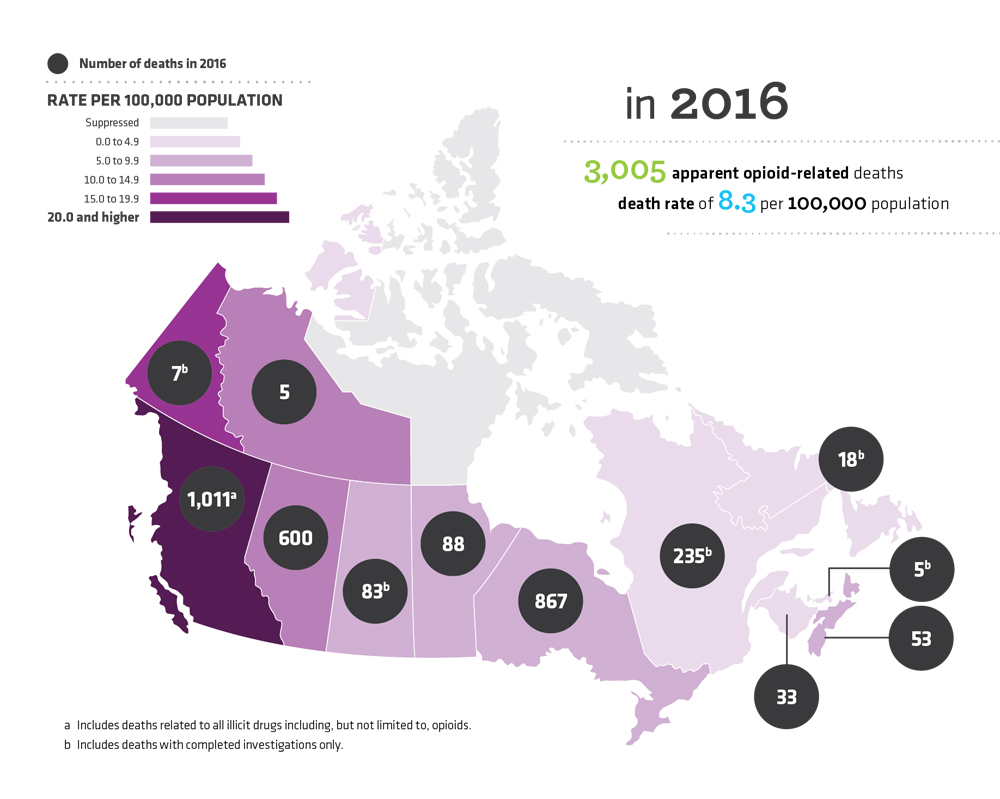
Text Description
In 2016
- 3005 apparent opioid-related deaths
- death rate of 8,3 per 100,000 population
| Province or territory | Number of deaths in 2016 | Rate per 100,000 population |
|---|---|---|
| British ColumbiaFigure 1 2016 Footnote 1 | 1011 | 21,2 |
| Alberta | 600 | 14,2 |
| SaskatchewanFigure 1 2016 Footnote 2 | 83 | 7,2 |
| Manitoba | 88 | 6,7 |
| Ontario | 867 | 6,2 |
| QuebecFigure 1 2016 Footnote 2 | 235 | 2,8 |
| New Brunswick | 33 | 4,4 |
| Nova Scotia | 53 | 5,6 |
| Prince Edward IslandFigure 1 2016 Footnote 2 | 5 | 3,3 |
| Newfoundland and LabradorFigure 1 2016 Footnote 2 | 18 | 3,4 |
| YukonFigure 1 2016 Footnote 2 | 7 | 18,4 |
| Northwest Territories | 5 | 11,2 |
| Nunavut | Suppressed | Suppressed |
|
||
2017
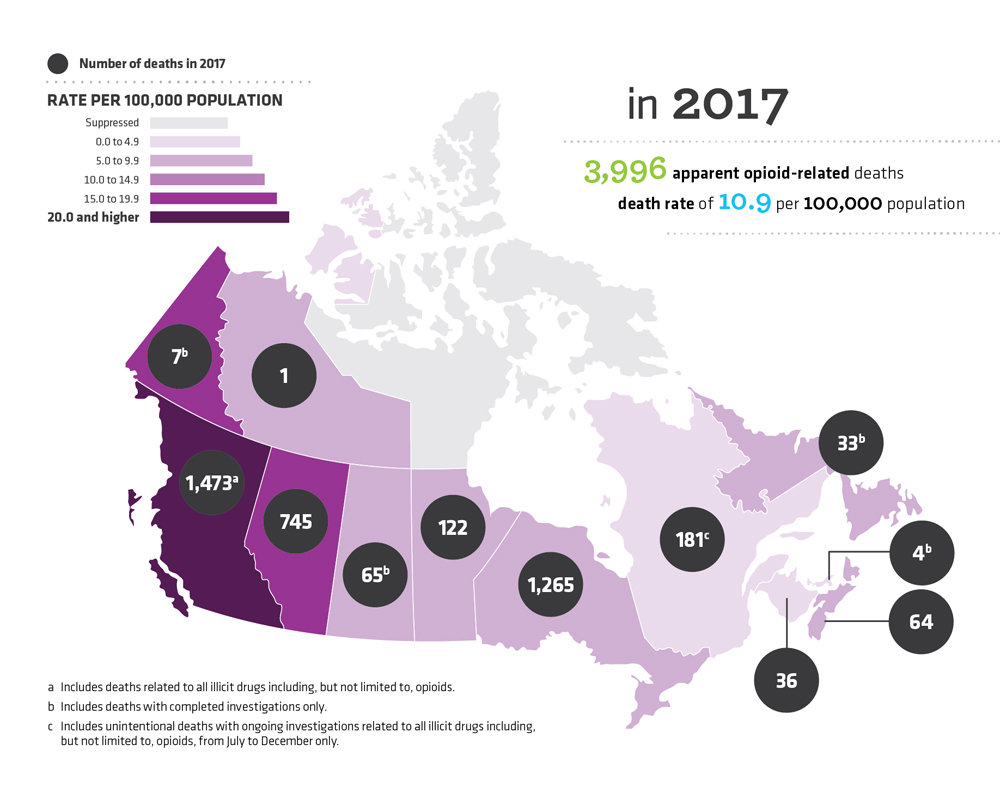
Text Description
In 2017
- 3996 apparent opioid-related deaths
- death rate of 10,9 per 100,000 population
| Province or territory | Number of deaths in 2017 | Rate per 100,000 population |
|---|---|---|
| British ColumbiaFigure 1 2017 Footnote 1 | 1473 | 30,6 |
| Alberta | 745 | 17,4 |
| SaskatchewanFigure 1 2017 Footnote 2 | 65 | 5,6 |
| Manitoba | 122 | 9,1 |
| Ontario | 1265 | 8,9 |
| QuebecFigure 1 2017 Footnote 3 | 181 | 2,2 |
| New Brunswick | 36 | 4,7 |
| Nova Scotia | 64 | 6,7 |
| Prince Edward IslandFigure 1 2017 Footnote 2 | 4 | 2,6 |
| Newfoundland and LabradorFigure 1 2017 Footnote 2 | 33 | 6,2 |
| YukonFigure 1 2017 Footnote 2 | 7 | 18,2 |
| Northwest Territories | 1 | 2,2 |
| Nunavut | Suppressed | Suppressed |
|
||
2018 (Jan to Mar)
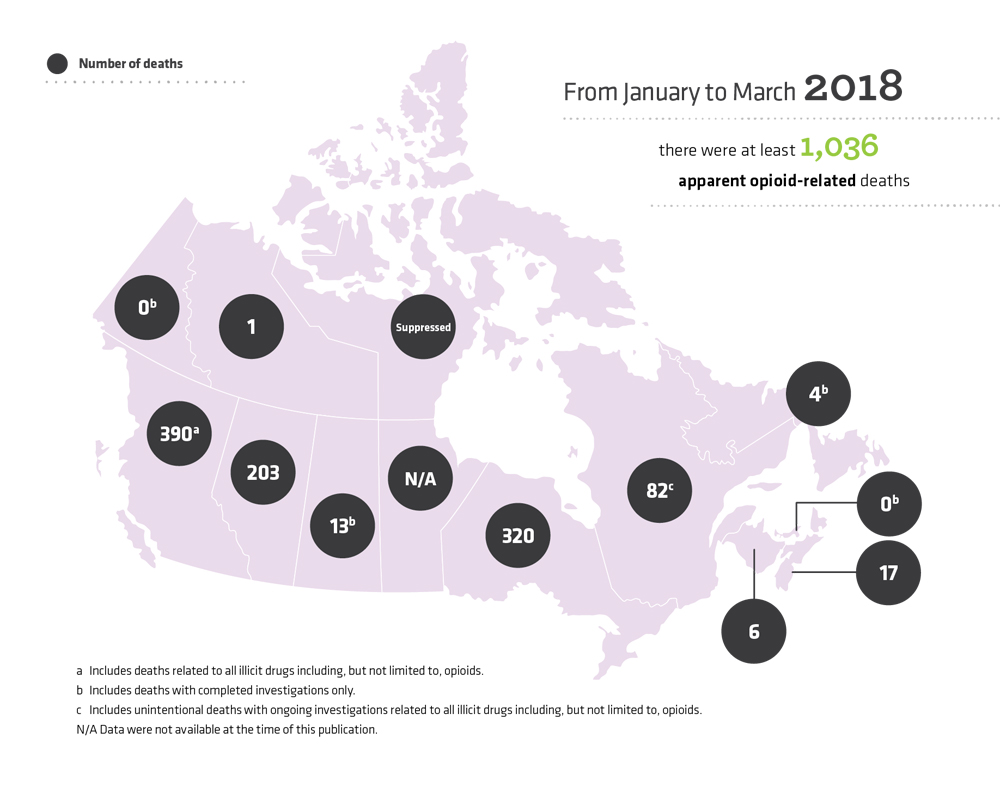
Text Description
From January to March 2018, there were at least 1,036 apparent opioid-related deaths
| Province or territory | Number of deaths |
|---|---|
| British ColumbiaFigure 1 2018 Footnote 1 | 390 |
| Alberta | 203 |
| SaskatchewanFigure 1 2018 Footnote 2 | 13 |
| Manitoba | N/A |
| Ontario | 320 |
| QuebecFigure 1 2018 Footnote 3 | 82 |
| New Brunswick | 6 |
| Nova Scotia | 17 |
| Prince Edward IslandFigure 1 2018 Footnote 2 | 0 |
| Newfoundland and LabradorFigure 1 2018 Footnote 2 | 4 |
| YukonFigure 1 2018 Footnote 2 | 0 |
| Northwest Territories | 1 |
| Nunavut | Suppressed |
N/A Data were not available at the time of this publication. |
|
| 2016 | 2017 | 2018 (Jan to Mar) | ||
|---|---|---|---|---|
| Number | 3005 | 3996 | 1036 | |
| Rate per 100,000 population | 8.3 | 10.9 | Not available | |
| Percent male | 71% | 76% | 76% | |
| Percent by age group (years) | 19 and under | 2% | 2% | 1% |
| 20 to 29 | 18% | 20% | 20% | |
| 30 to 39 | 26% | 27% | 27% | |
| 40 to 49 | 21% | 22% | 21% | |
| 50 to 59 | 23% | 20% | 22% | |
| 60 to 69 | 8% | 8% | 8% | |
| 70 and over | 2% | 1% | 2% | |
| Percent involvingTable 1 Footnote 2 fentanyl or fentanyl analogues | 50% | 69% | 70% | |
| Percent also involving non-opioid substancesTable 1 Footnote 3 | 75% | 72% | 71% | |
|
||||
1.1 Apparent opioid-related deaths by manner of death
The following section presents apparent opioid-related death data according to the manner of death assigned by the coroner or medical examiner during, or following an investigation (Table 2). Collecting data on how deaths occurred, including whether they were intentional or not, is critical in understanding how the opioid crisis is affecting Canadians.
Accident: Deaths with completed investigations where the coroner or medical examiner determined that the death was unintentional. This category also includes deaths with ongoing investigations where the manner of death was believed to be unintentional or had not been assigned at the time of reporting.
Suicide: Deaths with completed investigations where the coroner or medical examiner determined that the opioids were consumed with the intent to die. This category also includes deaths with ongoing investigations where suicide was believed to be the manner of death at the time of reporting.
Undetermined: Deaths with completed investigations where a specific manner of death (e.g. accident, suicide) could not be assigned based on available or competing information.
According to available data reported as of September 12, 2018, most (94%) apparent opioid-related deaths between January and March 2018 were accidental (unintentional), similar to both 2016 (88%) and 2017 (92%) (Table 2).
In other words, these data indicate that the vast majority of apparent opioid-related deaths were of individuals who did not intend to die. This distinction is important to inform an appropriate public health response. For example, the high percent of unintended deaths reinforces the concern that a variety of street drugs are tainted with toxic substances, such as fentanyl, without the knowledge of the people consuming them. Public health officials will be able to use this information in developing strategies to address these hidden risks in order to reduce harms and effectively prevent unintended apparent opioid-related deaths.
| Manner of death | 2016 | 2017 | 2018 (Jan to Mar) | |||
|---|---|---|---|---|---|---|
| Number | Percent | Number | Percent | Number | Percent | |
| Accident (unintentional) | 2643 | 88% | 3679 | 92% | 973 | 94% |
| Suicide | 266 | 9% | 194 | 5% | 39 | 4% |
| Undetermined | 96 | 3% | 123 | 3% | 24 | 2% |
| TotalTable 2 Footnote 2 | 3005 | - | 3996 | - | 1036 | - |
|
||||||
2.0 Accidental apparent opioid-related deaths
The following section provides detailed information on accidental apparent opioid-related deaths, which are deaths with completed investigations where the coroner or medical examiner determined that the death was unintentional. This category also includes deaths with ongoing investigations where the manner of death was believed to be unintentional or had not been assigned at the time of reporting.
| Province or territory | 2016 | 2017 | 2018 | ||||||
|---|---|---|---|---|---|---|---|---|---|
| Jan to Mar | Apr to Jun | Jul to Sep | Oct to Dec | Jan to Mar | Apr to Jun | Jul to Sep | Oct to Dec | Jan to Mar | |
| British ColumbiaTable 2a Footnote 2 | 218 | 192 | 196 | 371 | 396 | 408 | 325 | 286 | 371 |
| Alberta | 118 | 130 | 144 | 153 | 152 | 162 | 176 | 200 | 195 |
| Saskatchewan | 25 | 14 | 22 | 15 | 20 | 16 | 10 | 11 | 12 |
| Manitoba | 11 | 15 | 14 | 30 | 28 | 27 | 17 | 14 | N/A |
| Ontario | 174 | 180 | 174 | 198 | 191 | 276 | 380 | 280 | 287 |
| QuebecTable 2a Footnote 2 | 46 | 41 | 39 | 30 | N/A | N/A | 93 | 88 | 82 |
| New Brunswick | 11 | 3 | 6 | 6 | 8 | 7 | 7 | 9 | 5 |
| Nova Scotia | 14 | 8 | 15 | 3 | 17 | 16 | 12 | 13 | 16 |
| Prince Edward IslandTable 2a Footnote 3 | N/A | N/A | N/A | N/A | Suppressed | Suppressed | Suppressed | Suppressed | 0 |
| Newfoundland and Labrador | Suppressed | Suppressed | Suppressed | Suppressed | Suppressed | Suppressed | Suppressed | Suppressed | 4 |
| Yukon | 0 | 2 | 0 | 3 | 3 | 0 | 1 | 2 | 0 |
| Northwest Territories | 1 | 0 | 1 | 2 | 0 | 0 | 1 | 0 | 1 |
| Nunavut | Suppressed | Suppressed | Suppressed | Suppressed | Suppressed | Suppressed | Suppressed | Suppressed | Suppressed |
N/A – Data were not available at the time of this publication. Suppressed – Data may be suppressed in provinces or territories with low numbers of cases. Please see Considerations and Limitations for more information.
|
|||||||||
2.1 Annual, sex, and age trends of accidental apparent opioid-related deaths
This crisis has affected Canadians from all walks of life; however, available data reported as of September 12, 2018 indicate that the impact of the crisis differs by year, sex, and age.
Although these trends vary by province or territory, at the national level:
- there were 973 accidental apparent opioid-related deaths between January to March 2018 (Table 2a, Table 2b)
- the number of deaths in 2018 increased by 8% compared to the same time period in 2017 and more than doubled compared to the same time period in 2016 (Table 2a)
- in-line with previous trends observed in 2016 and 2017, most (77%) accidental apparent opioid-related deaths from January to March 2018 occurred among males (Figure 2.1)
- the highest percent (27%) of accidental apparent opioid-related deaths between January to March 2018 occurred among individuals between the ages of 30 and 39 (Figure 2.2)
| Province or territory | 2016 | 2017 | 2018 (Jan to Mar) |
|||||
|---|---|---|---|---|---|---|---|---|
| Number | Rate | Percent involving fentanyl or fentanyl analogues | Number | Rate | Percent involving fentanyl or fentanyl analogues | Number | Percent involving fentanyl or fentanyl analogues | |
| British ColumbiaTable 2b Footnote 2 | 977 | 20.5 | 67% | 1415 | 29.4 | 84% | 371 | 86% |
| Alberta | 545 | 12.9 | 64% | 690 | 16.1 | 81% | 195 | 87% |
| Saskatchewan | 76 | 6.6 | 11% | 57 | 4.9 | 23% | 12 | 50% |
| Manitoba | 70 | 5.3 | 46% | 86 | 6.4 | 49% | N/A | N/A |
| Ontario | 726 | 5.2 | 45% | 1127 | 7.9 | 69% | 287 | 67% |
| QuebecTable 2b Footnote 2 | 156 | 1.9 | 22% | 181 | 2.2 | 16% | 82 | 12% |
| New Brunswick | 26 | 3.4 | 15% | 31 | 4.1 | 23% | 5 | 0% |
| Nova Scotia | 40 | 4.2 | 18% | 58 | 6.1 | 12% | 16 | 19% |
| Prince Edward Island | 5 | 3.3 | 20% | 4 | 2.6 | 0% | 0 | Not applicable |
| Newfoundland and Labrador | 13 | 2.5 | Suppressed | 23 | 4.3 | Suppressed | 4 | Suppressed |
| Yukon | 5 | 13.1 | 80% | 6 | 15.6 | 83% | 0 | Not applicable |
| Northwest Territories | 4 | 9.0 | 25% | 1 | 2.2 | 0% | 1 | 0% |
| Nunavut | Suppressed | Suppressed | Suppressed | Suppressed | Suppressed | Suppressed | Suppressed | Suppressed |
| Total | 2643 | 7.3 | 54% | 3679 | 10.0 | 72% | 973 | 73% |
N/A – Data were not available at the time of this publication. Suppressed – Data may be suppressed in provinces or territories with low numbers of cases. Please see Considerations and Limitations for more information.
|
||||||||
Figure 2.1 Sex distribution of accidental apparent opioid-related deaths by province or territory.Footnote 1
2016
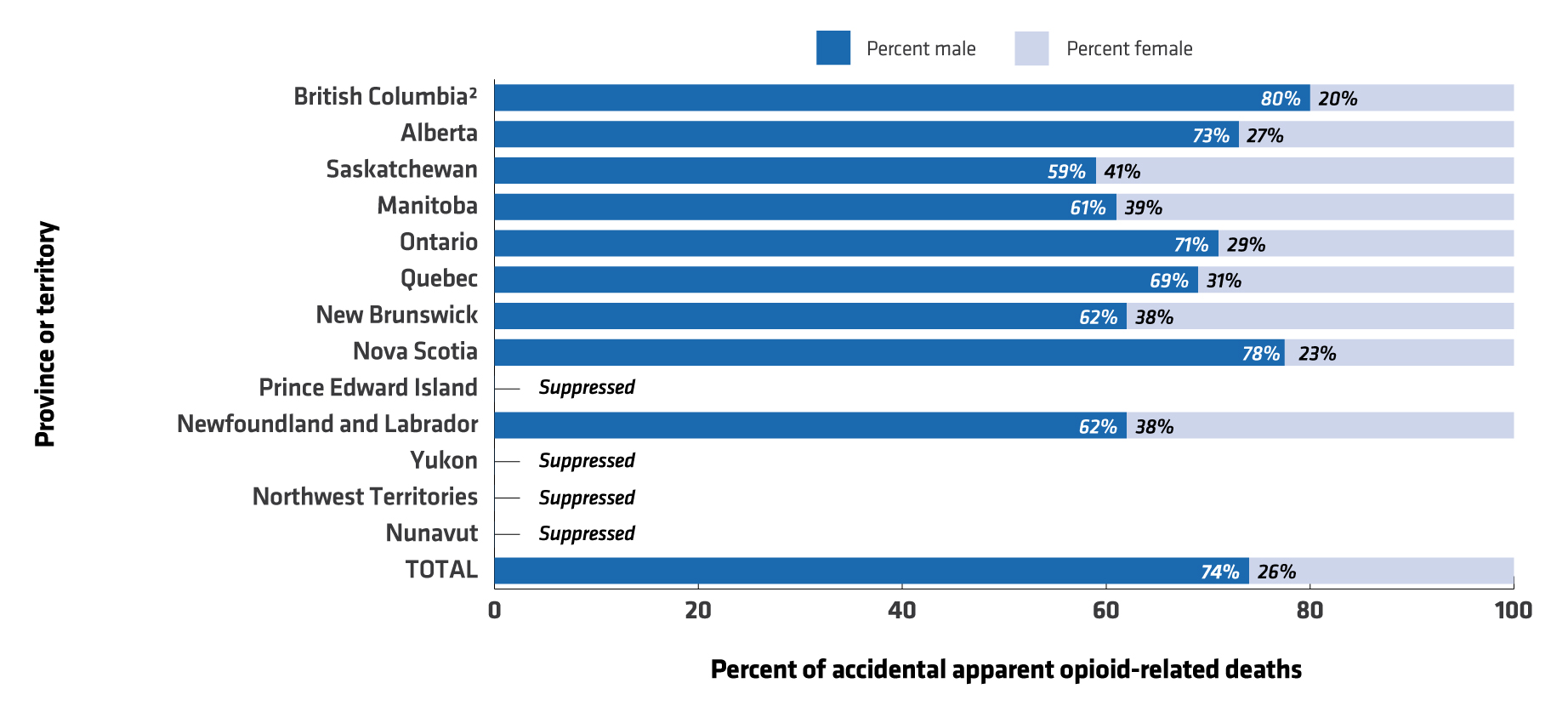
Text Description
| Province or territory | Percent of apparent opioid-related deaths | |
|---|---|---|
| Percent male | Percent female | |
| British ColumbiaFootnote 2 | 80% | 20% |
| Alberta | 73% | 27% |
| Saskatchewan | 59% | 41% |
| Manitoba | 61% | 39% |
| Ontario | 71% | 29% |
| Quebec | 69% | 31% |
| New Brunswick | 62% | 38% |
| Nova Scotia | 77.5% | 22.5% |
| Prince Edward Island | Suppressed | Suppressed |
| Newfoundland and Labrador | 62% | 38% |
| Yukon | Suppressed | Suppressed |
| Northwest Territories | Suppressed | Suppressed |
| Nunavut | Suppressed | Suppressed |
| Total | 74% | 26% |
|
||
2017
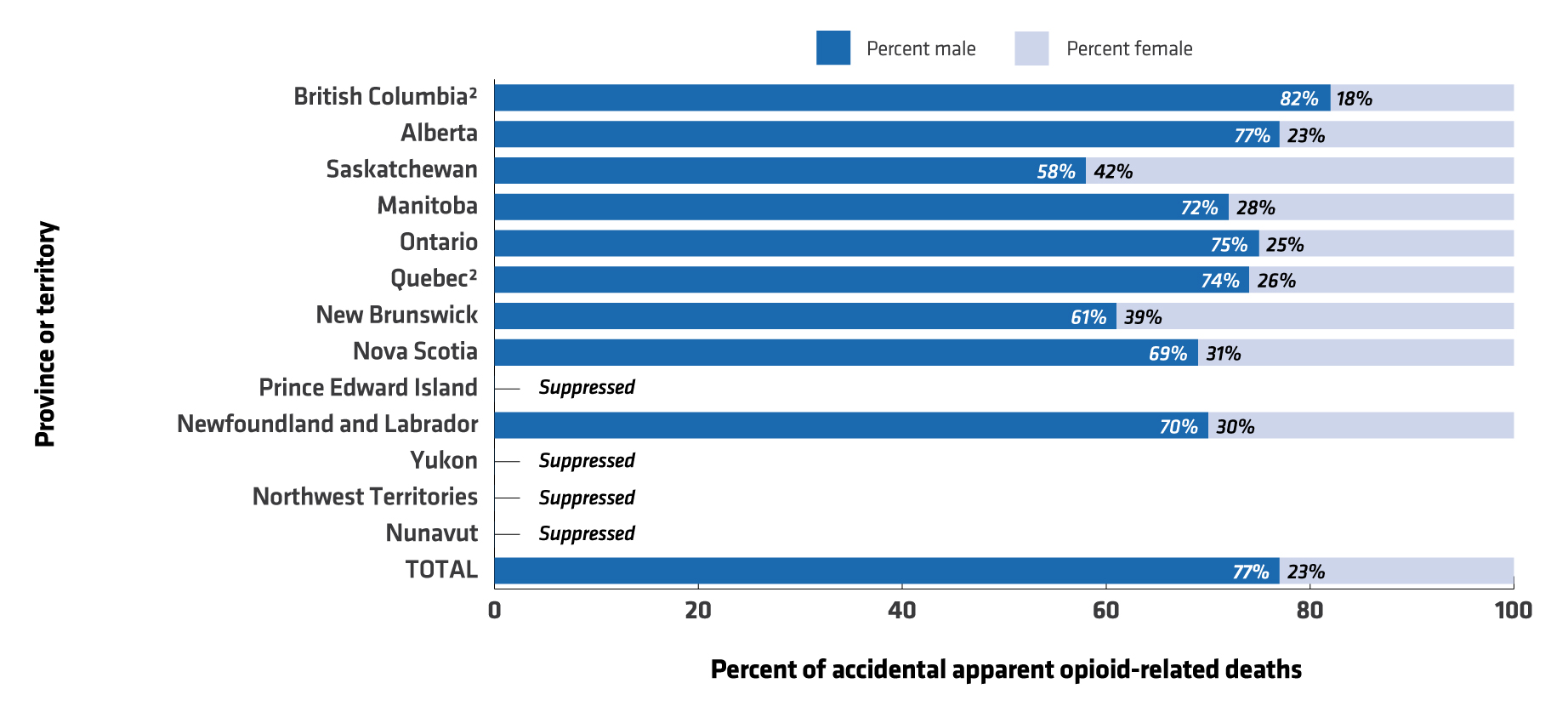
Text Description
| Province or territory | Percent of apparent opioid-related deaths | |
|---|---|---|
| Percent male | Percent female | |
| British ColumbiaFigure 2.1 2017 Footnote 2 | 82% | 18% |
| Alberta | 77% | 23% |
| Saskatchewan | 58% | 42% |
| Manitoba | 72% | 28% |
| Ontario | 75% | 25% |
| QuebecFigure 2.1 2017 Footnote 2 | 74% | 26% |
| New Brunswick | 61% | 39% |
| Nova Scotia | 69% | 31% |
| Prince Edward Island | Suppressed | Suppressed |
| Newfoundland and Labrador | 70% | 30% |
| Yukon | Suppressed | Suppressed |
| Northwest Territories | Suppressed | Suppressed |
| Nunavut | Suppressed | Suppressed |
| Total | 77% | 23% |
|
||
2018 (Jan to Mar)
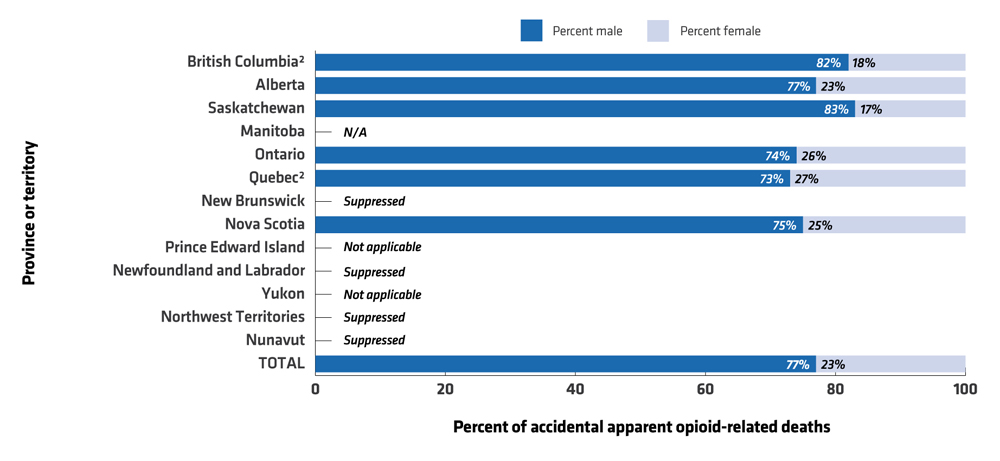
Text Description
| Province or territory | Percent of apparent opioid-related deaths | |
|---|---|---|
| Percent male | Percent female | |
| British ColumbiaFigure 2.1 2018 Footnote 2 | 82% | 18% |
| Alberta | 77% | 23% |
| Saskatchewan | 83% | 17% |
| Manitoba | N/A | N/A |
| Ontario | 74% | 26% |
| QuebecFigure 2.1 2018 Footnote 2 | 73% | 27% |
| New Brunswick | Suppressed | Suppressed |
| Nova Scotia | 75% | 25% |
| Prince Edward Island | Not applicable | Not applicable |
| Newfoundland and Labrador | Suppressed | Suppressed |
| Yukon | Not applicable | Not applicable |
| Northwest Territories | Suppressed | Suppressed |
| Nunavut | Suppressed | Suppressed |
| Total | 77% | 23% |
N/A Data were not available at the time of this publication. |
||
Suppressed – Data may be suppressed in provinces or territories with low numbers of cases. Please see Considerations and Limitations for more information.
Figure 2.2 Percent of accidental apparent opioid-related deaths by age group and province or territory.Footnote 1
2016
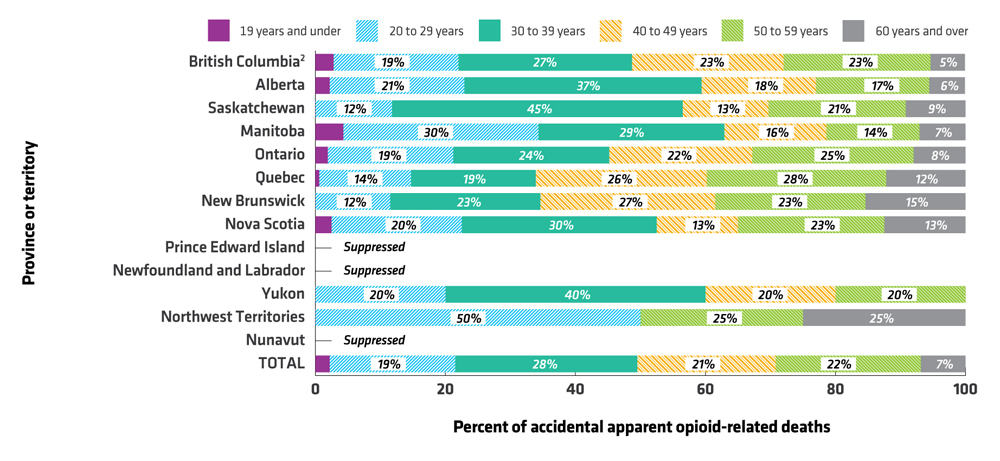
Text Description
| Province or territory | Age group | |||||
|---|---|---|---|---|---|---|
| 19 year and under | 20 to 29 years | 30 to 39 years | 40 to 49 years | 50 to 59 years | 60 years and over | |
| British ColumbiaFigure 2.2 2016 Footnote 2 | 2,8% | 19,2% | 26,7% | 23,3% | 22,6% | 5,3% |
| Alberta | 2,2% | 20,7% | 36,5% | 17,6% | 17,4% | 5,5% |
| Saskatchewan | 0,0% | 11,8% | 44,7% | 13,2% | 21,1% | 9,2% |
| Manitoba | 4,3% | 30,0% | 28,6% | 15,7% | 14,3% | 7,1% |
| Ontario | 1,9% | 19,3% | 24,0% | 22,0% | 24,8% | 8,0% |
| Quebec | 0,6% | 14,1% | 19,2% | 26,3% | 27,6% | 12,2% |
| New Brunswick | 0,0% | 11,5% | 23,1% | 26,9% | 23,1% | 15,4% |
| Nova Scotia | 2,5% | 20,0% | 30,0% | 12,5% | 22,5% | 12,5% |
| Prince Edward Island | Suppressed | Suppressed | Suppressed | Suppressed | Suppressed | Suppressed |
| Newfoundland and Labrador | Suppressed | Suppressed | Suppressed | Suppressed | Suppressed | Suppressed |
| Yukon | 0,0% | 20,0% | 40,0% | 20,0% | 20,0% | 0,0% |
| Northwest Territories | 0,0% | 50,0% | 0,0% | 0,0% | 25,0% | 25,0% |
| Nunavut | Suppressed | Suppressed | Suppressed | Suppressed | Suppressed | Suppressed |
| Total | 2,2% | 19,3% | 28,0% | 21,3% | 22,3% | 6,9% |
|
||||||
2017
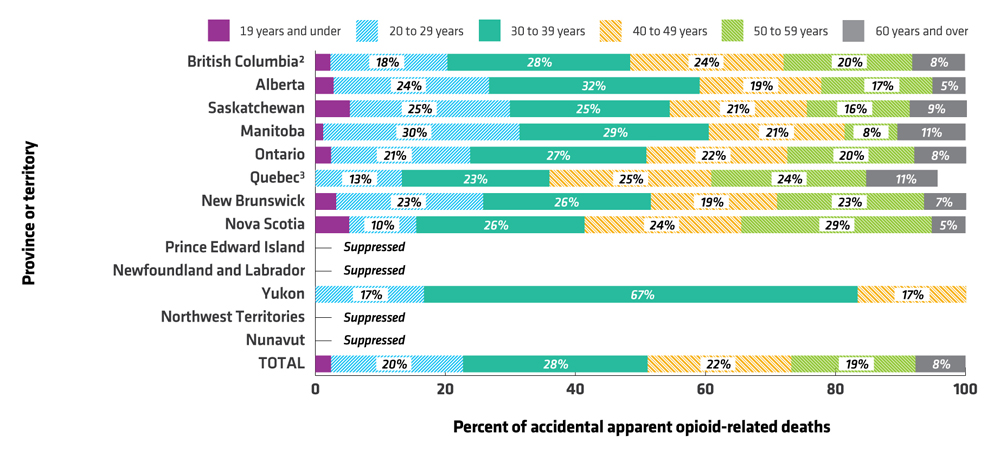
Text Description
| Province or territory | Age group | |||||
|---|---|---|---|---|---|---|
| 19 year and under | 20 to 29 years | 30 to 39 years | 40 to 49 years | 50 to 59 years | 60 years and over | |
| British ColumbiaFigure 2.2 2017 Footnote 2 | 2,3% | 18,0% | 28,1% | 23,6% | 19,8% | 8,1% |
| Alberta | 2,8% | 23,9% | 32,4% | 18,7% | 17,1% | 5,1% |
| Saskatchewan | 5,3% | 24,6% | 24,6% | 21,1% | 15,8% | 8,8% |
| Manitoba | 1,2% | 30,2% | 29,1% | 20,9% | 8,1% | 10,5% |
| Ontario | 2,4% | 21,4% | 27,1% | 21,7% | 19,5% | 8,0% |
| QuebecFigure 2.2 2017 Footnote 3 | Suppressed | 13,3% | 22,7% | 24,9% | 23,8% | 11,0% |
| New Brunswick | 3,2% | 22,6% | 25,8% | 19,4% | 22,6% | 6,5% |
| Nova Scotia | 5,2% | 10,3% | 25,9% | 24,1% | 29,3% | 5,2% |
| Prince Edward Island | Suppressed | Suppressed | Suppressed | Suppressed | Suppressed | Suppressed |
| Newfoundland and Labrador | Suppressed | Suppressed | Suppressed | Suppressed | Suppressed | Suppressed |
| Yukon | 0,0% | 16,7% | 66,7% | 16,7% | 0,0% | 0,0% |
| Northwest Territories | Suppressed | Suppressed | Suppressed | Suppressed | Suppressed | Suppressed |
| Nunavut | Suppressed | Suppressed | Suppressed | Suppressed | Suppressed | Suppressed |
| Total | 2,4% | 20,3% | 28,4% | 22,1% | 19,1% | 8,1% |
|
||||||
2018 (Jan to Mar)
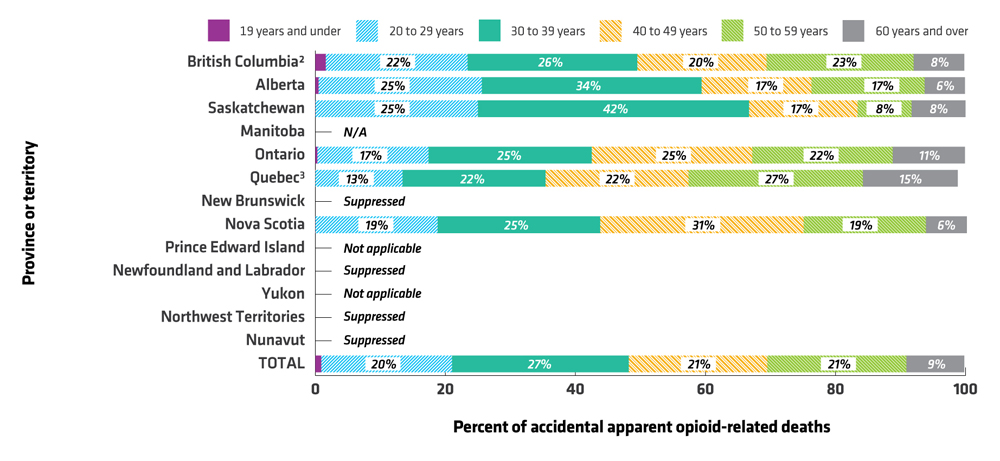
Text Description
| Province or territory | Age group | |||||
|---|---|---|---|---|---|---|
| 19 year and under | 20 to 29 years | 30 to 39 years | 40 to 49 years | 50 to 59 years | 60 years and over | |
| British ColumbiaFigure 2.2 2018 Footnote 2 | 1,6% | 21,8% | 26,1% | 19,9% | 22,6% | 7,8% |
| Alberta | 0,5% | 25,1% | 33,8% | 16,9% | 17,4% | 6,2% |
| Saskatchewan | 0,0% | 25,0% | 41,7% | 16,7% | 8,3% | 8,3% |
| Manitoba | Not available | |||||
| Ontario | 0,3% | 17,1% | 25,1% | 24,7% | 21,6% | 11,1% |
| QuebecFigure 2.2 2018 Footnote 3 | Suppressed | 13,4% | 22,0% | 22,0% | 26,8% | 14,6% |
| New Brunswick | Suppressed | |||||
| Nova Scotia | 0,0% | 18,8% | 25,0% | 31,3% | 18,8% | 6,3% |
| Prince Edward Island | Not applicable | |||||
| Newfoundland and Labrador | Suppressed | |||||
| Yukon | Not applicable | |||||
| Northwest Territories | Suppressed | |||||
| Nunavut | Suppressed | |||||
| Total | 0,9% | 20,1% | 27,2% | 21,3% | 21,4% | 8,9% |
|
||||||
Suppressed – Data may be suppressed in provinces or territories with low numbers of cases. Please see Considerations and Limitations for more information.
2.2 Fentanyl, fentanyl analogues, and other substances involved in accidental apparent opioid-related deaths
Apparent opioid-related deaths often involveFootnote a multiple substances including one or more opioids as well as non-opioid substances. Knowing the opioid and non-opioid substances involved in these deaths can help public health officials and other government agencies communicate risks and target harm reduction efforts.
Available data reported as of September 12, 2018, suggest that:
- between January and March 2018, 73% of accidental apparent opioid-related deaths involved fentanyl or fentanyl analogues (Table 2a, Figure 2.3)
- the number of accidental apparent opioid-related deaths involving fentanyl or fentanyl analogues increased by 16% compared to the same time frame in 2017, and doubled compared to the same time frame in 2016 (Figure 2.3)
In addition, available data suggest approximately 76% of accidental apparent opioid-related deaths between January 2016 and March 2018Footnote b also involved one or more types of non-opioid substances.
Figure 2.3. Number of accidental apparent opioid-related deaths involving or not involving fentanyl or fentanyl analogues by quarter, January 2016 to March 2018.Figure 2.3 Footnote 1Figure 2.3 Footnote 2
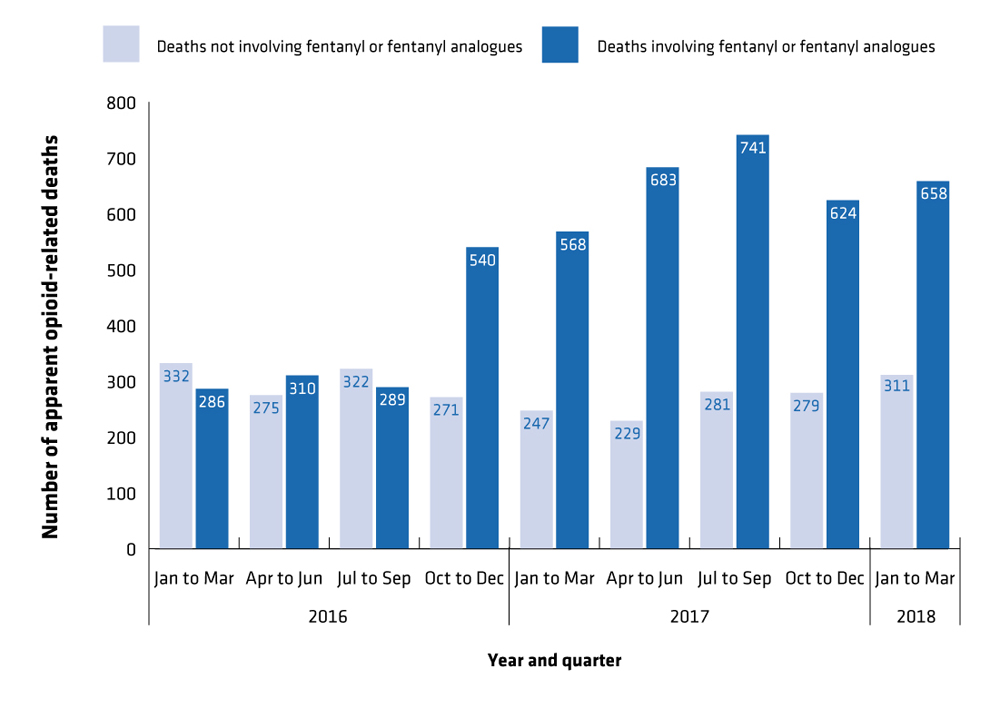
Text Description
| Year and quarter | Number of apparent opioid-related deaths | ||
|---|---|---|---|
| Deaths not involving fentanyl or fentanyl analogues | Deaths involving fentanyl or fentanyl analogues | ||
| 2016 | Jan to Mar | 332 | 286 |
| Apr to Jun | 275 | 310 | |
| Jul to Sep | 322 | 289 | |
| Oct to Dec | 271 | 540 | |
| 2017 | Jan to Mar | 247 | 568 |
| Apr to Jun | 229 | 683 | |
| Jul to Sep | 281 | 741 | |
| Oct to Dec | 279 | 624 | |
| 2018 | Jan to Mar | 311 | 658 |
|
|||
- Figure 2.3 Footnote 1
-
Data reported by some provinces and territories do not include all stages of investigation (ongoing, completed) or time periods; refer to Table 4 for more details. Updates to previously reported data will be provided in future reports. This graph does not include data from Prince Edward Island, Newfoundland and Labrador, or Nunavut. Data from British Columbia and available data from Quebec for 2017 (June to December) and 2018 include deaths related to all illicit drugs including, but not limited to, opioids; data on deaths related to illicit drugs where fentanyl was detected is used here to approximate apparent opioid-related deaths involving fentanyl.
- Figure 2.3 Footnote 2
-
These data are preliminary and subject to change; observed trends should be interpreted with caution until additional data become available.
3.0 Apparent opioid-related deaths: suicide
The following section provides information on apparent opioid-related deaths where the coroner or medical examiner determined that the opioids were consumed with the intent to die. This section also includes deaths with ongoing investigations where the manner of death was believed to be suicide at the time of reporting.
| 2016 | 2017 | 2018 (Jan to Mar) |
||
|---|---|---|---|---|
| Number | 266 | 194 | 39 | |
| Rate per 100,000 population | 0.7 | 0.5 | Not available | |
| Percent male | 46% | 52% | 62% | |
| Percent by age group (years) | 19 and under | 2% | 1% | 3% |
| 20 to 29 | 8% | 12% | 15% | |
| 30 to 39 | 12% | 15% | 10% | |
| 40 to 49 | 19% | 15% | 13% | |
| 50 to 59 | 29% | 28% | 33% | |
| 60 to 69 | 22% | 18% | 18% | |
| 70 and greater | 10% | 11% | 8% | |
| Percent involvingTable 3 Footnote 2 fentanyl or fentanyl analoguesTable 3 Footnote 3 | 13% | 16% | 18% | |
| Percent also involving non-opioid substancesTable 3 Footnote 4 | 83% | 79% | 64% | |
|
||||
Considerations and Limitations
Definition of an apparent opioid-related death
An apparent opioid-related death is a death caused by an intoxication/toxicity (poisoning) resulting from substance use, where one or more of the substances is an opioid, regardless of how it was obtained (e.g. illegally or through personal prescription).
How apparent opioid-related deaths are counted
Counts are provided by the provinces and territories that collect data from their respective offices of Chief Coroners or Medical Examiners. Rates are calculated using the most current population data from Statistics Canada.
The data provided by the provinces and territories can include deaths:
- with completed or ongoing investigations
- where manner of death is classified as accident, suicide, or undetermined
These data do not include deaths due to:
- the medical consequences of long term substance use or overuse (for example, alcoholic cirrhosis)
- medical assistance in dying
- trauma where use of the substance(s) contributed to the circumstances of the injury that lead to the death, but was not directly involved in the death
- homicide
However, some provincial and territorial differences remain in the type of data reported and in the time periods for which data are available (refer to Table 4).
| BCTable 4 Footnote 1 | AB | SK | MB | ONTable 4 Footnote 2 | QCTable 4 Footnote 3 | NB | NS | PE | NLTable 4 Footnote 4 | YT | NT | NUTable 4 Footnote 5 | ||
|---|---|---|---|---|---|---|---|---|---|---|---|---|---|---|
| Reporting period (as of September 12, 2018) | ||||||||||||||
| 2016 | January to December | (C) | (C) | (C) | (C) | (C) | ||||||||
| 2017 | January to December | (C) | INC | (C) | (C) | (C) | ||||||||
| 2018 | January to March | (C) | N/A | (C) | (C) | |||||||||
| Classification of deaths included in the reported data | ||||||||||||||
| Accident | Completed investigations | N/A | ||||||||||||
| Ongoing investigations where manner of death was believed to be unintentional | - | N/A | - | N/A | N/A | N/A | N/A | |||||||
| Ongoing investigations where manner of death had not been assigned at the time of reporting | - | N/A | N/A | N/A | - | - | N/A | |||||||
| Suicide | Completed investigations | N/A | N/A | |||||||||||
| Ongoing investigations where the manner of death was believed to be suicide | N/A | N/A | - | N/A | N/A | N/A | N/A | N/A | ||||||
| Deaths with completed investigations and an undetermined manner of deathTable 4 Footnote 6 | N/A | N/A | ||||||||||||
|
||||||||||||||
Data suppression
The suppression of data in this report is based on the preferences of individual provinces or territories to address concerns around releasing small numbers for their jurisdiction.
- Prince Edward Island suppressed counts between one and four for quarterly data, and for any data related to sex or age distribution.
- Newfoundland and Labrador suppressed counts between one and four for quarterly data, and data related to substances involved and sex or age distribution.
- Quebec suppressed counts less than five for deaths with ongoing investigations (July to December 2017, 2018).
- Nunavut suppressed all counts less than five.
In addition, suppression was applied in some instances where all data for a province or territory fell in a single category of a given table or figure.
Opioids and other substances
Fentanyl and fentanyl analogues include, but are not limited to:
- 3-methylfentanyl
- acetylfentanyl
- butyrylfentanyl
- carfentanil
- cyclopropyl fentanyl
- despropionyl-fentanyl
- fentanyl
- furanylfentanyl
- methoxyacetylfentanyl
- norfentanyl
Non-fentanyl-related opioids include, but are not limited to:
- buprenorphine metabolites
- codeine
- dihydrocodeine
- heroin
- hydrocodone
- hydromorphone
- loperamide
- meperidine
- methadone
- monoacetylmorphine
- morphine
- normeperidine
- oxycodone
- tapentadol
- tramadol
- U-47700
Non-opioid substances include, but are not limited to:
- alcohol
- benzodiazepines
- cocaine
- gabapentin
- methamphetamine
- W-18
Limitations of these apparent opioid-related deaths data
Data presented in this report should be interpreted with caution.
- This report is based on data submitted to the Public Health Agency of Canada on or before September 12, 2018. New or revised data reported after this date will be reflected in future reports.
- Data released by provinces and territories may differ from the data provided in this report due to the availability of updated data, differences in the type of data reported (e.g. manners of death), the use of alternate age groupings, differences in time periods presented and/or population estimates used for calculations, etc.
- As some data are based on ongoing investigations by coroners and medical examiners, they are considered preliminary and subject to change. The time required to complete an investigation and related administrative processes is case-dependent and can range from approximately three to twenty-four months.
- This report is based on data that do not specify how the opioids were obtained (e.g. illegally or through personal prescription); the level of toxicity may differ depending on the opioid (substance(s) involved, concentration, and dosage).
- Jurisdictional differences in the death investigation process, death classification method, toxicology testing, and the manners of death reported may impact the interpretation and comparability of the data presented in this report.
- Information related to changes over time at the national level is based only on jurisdictions where data were available for all time periods of interest.
- Rates reported here have not been adjusted for existing differences in provincial and territorial age distributions.
- Rates for jurisdictions with relatively smaller populations may change substantially with even slight changes in the number of deaths. As a result, comparisons over time and between provinces and territories should be interpreted with caution.
Footnotes
- Footnote a
-
Given jurisdictional differences in death classification methods, the term “involve” includes deaths where the substance was either detected and/or directly contributed to the death.
- Footnote b
-
Data were not available from British Columbia, or Nunavut. For Alberta and Ontario, only data on deaths with completed investigations were included in these percentages. Data for non-opioid substances from Ontario between January 2017 and April 2017 were based on their detection and do not include alcohol; as of May 1, 2017, data on non-opioid substances are based on their direct effects and include alcohol. Data for non-opioid substances from Quebec were available for 2016 only.